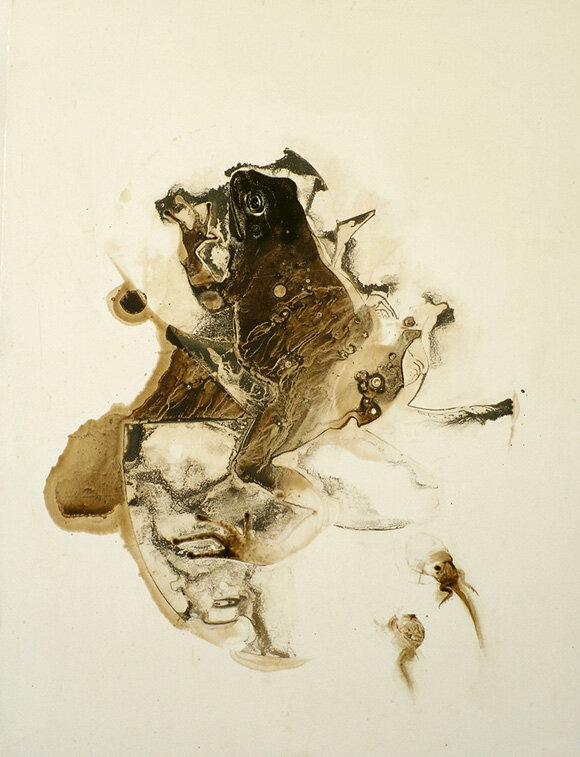From Tar Pits: James Griffith’s Petro-Artistic Paintings
"Natural Selection," Tar on Canvas, 36x28, 2012. | Photo: Courtesy of the artist.
Oil. The world runs on it. Despite major inroads in sustainable energy sources, it still powers about 80% of our systems. Though unquestionably an integral part of the modern world, fossil fuels were borne out of ancient animal remains. This tension between past and present within this unusual medium is what keeps artist James Griffith coming back.
"When I thought of tar as a material, I loved it because on one hand it is this primordial goo. At the same time, it's at the heart of the whole environmental problem. It has a contemporary quality and but also an incredibly ancient timeline quality. I just love that," says Griffith, as he sits in his Altadena studio, surrounded by his artworks, which will soon form the body of his solo show at the El Camino College Art Gallery.
Portrait of the artist. | Photo: Carren Jao.
Griffith uses the sticky, smelly tar oozing out of the La Brea tar pits on each of his naturalist paintings. He first discovered its painterly uses about four years ago when he experimented with asphaltum, a gooey brown material traditionally used in the printmaking process, as a substitute for paint.
While showing his friends some test paintings, one of them astutely remarked, "You know, you can get that stuff for free at the La Brea Tar pits." The idea captivated Griffith, who promptly called up the George C. Page Museum, which operates the site, to set up an appointment. The museum opened its doors to Griffith, who then collected a bucket of tar from Pit # 91.
Natural materials used in Griffith's paintings. | Photo: Carren Jao.
The artist's many tools. | Photo: Carren Jao.
Tar from the La Brea Tar pits. | Photo: Carren Jao.
Before Griffith could use the tar, however, he became a backyard scientist, essentially coming up with his own formula for tar paint. "It was a total shot in the dark. I'm an artist and not a chemist. I read a lot of books to figure things out," says Griffith, "It's a little bit of alchemy." By mixing in driers, the artist was able to thin out the sticky tar enough to wield it to his purposes.
With his bucket of tar, Griffith brings to life emotion-filled portraits of animal life that --almost magically -- appear out of a minimalist Zen-like backdrop. What at first seems like a splash of muddy paint morphs into the unmistakable silhouette of a tree frog, whose knowing eyes prompt mental images of Amazon rainforests or rainy nights in the wilderness. A dark swirl becomes the curve of a swan's neck as it protects her nest from an invading crow.
"Natural Selection - Amphibious 1," tar on panel, 24x18. | Photo: Courtesy of the artist.
Much like his tension-filled material, Griffith's style also treads the fine line between gesture and precision. His backgrounds read like bold strokes of Japanese ink wash, but out of this arises foregrounds of exquisite delicacy.
To create the image of the tree frog, Griffith first poured a bit of paint onto his canvas. After contemplating the resulting paint blob, he then came back to the edge and inscribed the frog's face with an X-acto knife, massaging fine detail so it fits seamlessly onto the larger picture.
Griffith calls his process "improvisational." He never knows ahead of time what exactly will come out of every canvas. Though it only takes a few minutes to pour down paint onto his canvas, it may take the artist weeks of repeatedly looking at the resulting squiggles or blobs to come up with just the right detail to complete his painting.
"I try and paint animals in the paintings not as symbols but as something you can sense that they're fellow travelers along with us," says Griffith.
Detail - "Observer," Tar and Copper Sulphate on Panel. | Photo: Courtesy of the artist.
"Dark Wings," tar and drain cleaner on aluminum, 2011, 10x8.| Photo: Courtesy of the artist.
His paintings evoke a nostalgic look back into the past with its monochromatic sepia tone. Knowing such a limited color range can prove tiring to the eye, Griffith is continually in search of easily accessible materials to add color to his work. Every nature hike was an excuse to find new material.
To date, his list of pigments come from: the yellow pollen harvested from deodar cedars surrounding his home; a red mineral rock from Utah; and blue copper sulfate, a compound found in many drain cleaners. Griffith sifts each one and stores the resulting powder in glass bottles with stoppers, neatly tagged and labeled.
"I was trying everything that I can find that would add color, but wouldn't be from the art store because I decided that I wanted to use just natural materials or materials I found under the kitchen sink," says the artist with a laugh.
Griffith's experiments paid off. Spots of color bloom in his coffee-colored works. In "Little Planets," sepia-toned spheres were tinged with hints of red or blue or yellow. He applies color sparingly, however, preferring instead to concentrate on the craft of bringing these animals to life on canvas.
From careless whirls of tar, Griffith again and again conjures compelling images of fauna that, like many of us, are just looking to make it through the day. "When I get the drawing down to where I feel like there's a thought in that animal's head and it communicates not just like, 'Oh, a duck!' but 'a duck that's thinking about something,' then I know I've finished," says Griffith, "That's my simple goal. I want people to experience empathy."








